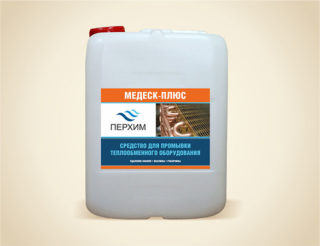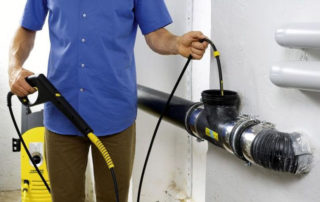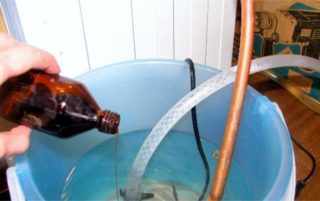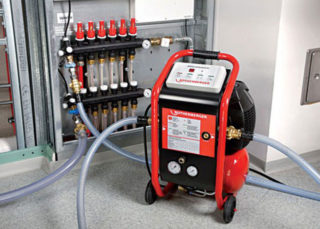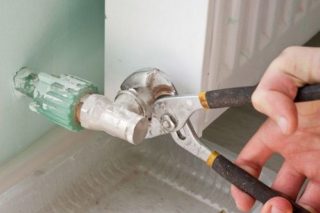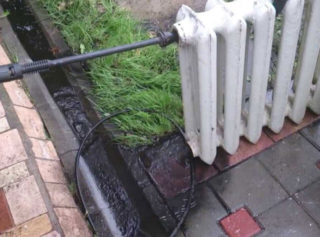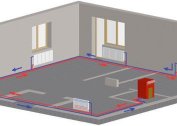Over time, heating appliances lose their effectiveness, this is displayed on the quality of heating. One of the reasons for poor performance is contamination of the radiator. You can fix the problem by flushing the battery. There are various effective methods, they need to be applied depending on the type of radiator and the degree of contamination.
Key signs of flushing
There are several signs of the accumulation of a large number of foreign elements inside the radiator and the formation of scale on the walls. This can be diagnosed by carefully monitoring the operation of the entire heating system.
If the system is malfunctioning, the following symptoms will appear:
- warming up the system takes a longer amount of time than before;
- the operation of the boiler is accompanied by strange sounds;
- gas or electricity consumption increases;
- temperature differs in different parts of the radiator;
- radiators are colder than lead pipes.
Most often, radiator cleaning is necessary when the battery is connected to a central heating system. This is due to the large length of the highway, a large number of connected equipment.
Causes of pollution of heating appliances
The heating efficiency of a room is reduced as a result of two processes that are especially characteristic of apartment buildings. Cleaning radiators is necessary when deposits form in the batteries and the horizontal pipes connected to them. This problem often arises in places where the coolant moves slowly, for example, in areas of spills, in the connection to the equipment, in the devices themselves.
It is necessary to find a way to clean the parts of the heating radiator, as some of them are heavily flooded due to the vast internal volume. The larger the volume with a fixed diameter of the risers and supply pipes, the slower the fluid circulates in them, the amount of sediment increases.
The heat carrier moving along the heating main carries with it elements of sand, rust, scale and other pollutants. In addition, the CHPP heats a lot of water during the heating period, while ideally filtering it does not work. Solid particles are also transported with it.
Some types of pipes are harmed by mineral deposits. Deposits of magnesium and calcium salts appear on the inner walls. Since they are a solid precipitate, the lumen of the pipes gradually decreases, due to which the heating efficiency decreases.
Particles of sand, silt and other suspended solids slow down the circulation of the coolant in heating devices. When they accumulate in large quantities, water begins to move only along the first sections of the radiator, which reduces the heating efficiency.
When the lumen in the pipe completely disappears, the radiator section ceases to function. Therefore, owners of apartments and private houses need to know how to flush the heating batteries at home and how often to do this in order to restore the heating system.
Reagents for cleaning the radiator
Various substances are used to clean the heating system. Someone washes radiators with citric acid, someone with caustic salt or Coca-Cola. If a person does not have confidence in folk remedies, store-bought preparations can be used, usually they are presented in a large assortment.
The following substances are popular:
- Cillit-HS, the liquid destroys corrosion, limescale and sludge, the substances may differ from each other, but almost all of them are suitable for washing and cleaning batteries whose operating temperature does not exceed 80 degrees.
- Medesk and Medesk plus, destroy deposits, are safe for pipes and batteries, do not violate the integrity of seals and gaskets, and protective clothing is needed when used. After flushing with this substance, rinse the radiator with clean water.
- Docker Thermo, designed for flushing heat exchange equipment, does not harm metal, does not contain harmful components, does not corrode rubber parts of devices.
- Metalin T, created on the basis of hydrochloric acid, removes powerful deposits, rust, organics, can be used in steel appliances and in non-ferrous metal equipment.
- Master Boiler Power, the liquid is able to clean the radiator from any type of metal, completely eliminates organics and dense deposits, the drug is not toxic, not flammable, you can not use protective equipment when working with it.
- Deoxyl-3, a chemical cleaner for pipelines and radiators, is an acid type, non-flammable, 3rd category of toxicity, individual protection is required when using, since the liquid is harmful to people.
Many substances are intended only for cast iron and steel products, it is impossible to wash the aluminum radiator with them. For this purpose, the substance Cillit-HS, as well as all folk remedies, are suitable.
Chemicals quickly and efficiently clean heating appliances, while not harming them. The components that make up the substances break down deposits and flush dirt out of the battery sections.
Methods for flushing the radiator
You can rinse the radiator in different ways, depending on the degree of contamination of the battery and supply pipes. Some methods can be implemented independently, for others it is recommended to involve specialists or purchase the appropriate equipment.
To choose a method, you need to find out how long the radiator was flushed, and assume how much rain is inside the battery.
It is recommended to flush radiators once a year, after the heating period. In this case, all radiators should be flushed, regardless of their technical characteristics. Flushing means should be selected based on the material - cast iron, aluminum, steel or some other.
Hydrodynamic
To clean the radiator in this way, you need to purchase special equipment. Rinsing water is not supplied using a regular tap hose, but from a pump under high pressure.
Sometimes the pump is connected to the gap of the heating circuit at a large distance from the discharge point, flushing the battery of water. However, a hose with a trailer can also be used for these purposes. Such a nozzle has small openings, through which water flows under pressure.
The accented effect due to the water supplied under pressure effectively fights various types of deposits. For better flushing of problem areas, the supply hose can be specially stopped.
A water jet can remove only substances that are soluble in water from the battery. Other deposits will remain in the pipes.
When selecting a hose, its stiffness must be taken into account. The larger it is, the further you can apply pressure from the input. In turning areas, such a hose will be problematic to advance. It will be necessary to open the heating circuit in certain places so that water can penetrate to all points.
The hydrodynamic flushing method is environmentally friendly, effective in relation to cast iron and aluminum radiators.
Chemical
This cleaning option can be used both in a private and in an apartment building.Chemical reagents are used. The method is accessible to everyone, the means are cheap, quickly and effectively eliminate deposits. You can rinse in winter and summer. All reagents remove salt and rust.
To clean the battery with a chemical option:
- choose the right drug;
- dilute the reagent, if required by the instruction;
- prepare a cleaning structure;
- introduce a chemical into the heating system and allow it to stay inside for some time;
- drain the liquid;
- flush the system several times, fill with water.
The chemical method has one drawback - the reagents are toxic, in most cases protection is necessary so that the funds do not harm the person.
Pneumohydropulse
Reagents are completely poured into the system. After this, periodic oscillations occur, under the influence of electrical impulses. They contribute to the fact that deposits are removed from the walls and washed out with the chemical product.
This method requires special skills, so it is better to seek help from specialists who will assess the degree of contamination and apply the right dose of electrical exposure.
Hydropneumatic
This option will allow you to clean the radiator from metal. Before washing the cast-iron battery between sections, it is necessary to purchase a compressor. It is connected to one of the equipment inputs through a non-return valve and at high pressure direct air into the battery.
Due to the high pressure, the elements of growths and deposits are torn off. Then they are washed out of the heating system.
To use this method you need:
- shut off water;
- connect a compressor with an air gun;
- connect the hose to the opposite end and direct it into the drain tank;
- supply air to the radiator under pressure;
- so that there is no dirt left, the device is washed, then connected to the coolant and the system is started.
The hydropneumatic method is based on shock waves, in total they may need from 2 to 5. It takes several minutes, does not require electricity, is installed independently.
Cleaning radiators in the house and apartment
In the apartment
If you need to rinse in an apartment building, you must wait for the end of the heating season. Before starting the process, all liquid is drained from the radiator and dismantled. You can purchase chemicals or use folk remedies.
Next, follow the instructions:
- the battery is placed in the bath;
- if the equipment is cast-iron, plugs are removed from it;
- pour hot water inside, for the first time do not use excipients;
- the heater is well shaken and drained;
- prepared chemical solution is poured, holes are plugged with plugs;
- the equipment is left in this condition for several hours;
- the solution is poured, the battery is washed with water and replaced.
If you do not completely get rid of the cleaning product, it can cause the destruction of the heating equipment.
In a private house
In suburban areas, it is more difficult to clean heating appliances. The problem is that water does not come from a centralized water supply system, but from ponds and wells. Because of this, a large number of different foreign elements and dirt can accumulate in radiators.
If you do not use a filtered station, the heating equipment will clog much faster than what happens in apartments. Therefore, the need for purging and flushing batteries with private sector residents arises more often.
If the battery of a private house is cleaned, it is necessary to clean the heater and the highway itself along which the coolant moves.Otherwise, the debris in the radiator will again fall into the heater, and flushing operations will be a waste of time.
You do not need to wait for the end of the heating season, however, it will not be practical to conduct this event in winter, since the heating system will turn off. You can apply the same method as in cleaning apartment heating appliances.
In the heating season
When the cleaning procedure is carried out during the heating season, chemicals or folk remedies, such as alkali or acetic acid, can be used.
It is not necessary to drain water from the heating device. Also, you do not need to remove the battery from its place. The steam line should be closed during the cleaning operation. After the necessary valves are closed, the heaters are purged, and then the radiator is cleaned.
To clean the battery, water is passed through its circuit. It must be supplied until a clean liquid flows from the pipeline, without impurities and debris. Thanks to this, you can clear the entire highway.


